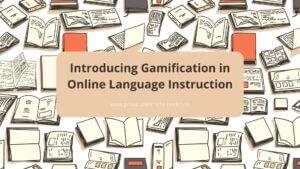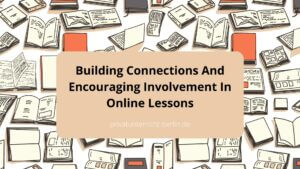Your Language Journey, Your Way: Start with a Private Tutor

Designing A Productive Online Environment For Language Studies
Welcome to the world of online language studies. As a curriculum designer, I understand the importance of creating a productive environment for students to learn and practice their target language.
With the rise of technology in education, more and more learners are turning towards online courses as an efficient method to improve their linguistic abilities.
However, more than simply providing access to materials and exercises are required.
A successful online language course requires careful consideration of student engagement, motivation, communication tools, feedback methods, and cultural sensitivity.
In this article, we will explore how designing a productive online environment can enhance the learning experience for language students and lead them toward success in their language goals.
Table of Contents
Engaging Students In The Learning Process
Did you know that interactive exercises and group collaboration can increase student engagement in language studies by up to 75%?
As an online language curriculum designer, it’s crucial to incorporate these elements into the learning process. By providing opportunities for students to interact with one another and actively participate in their education, we can create a more dynamic and rewarding experience.
One way to do this is through gamification. Incorporating games into language lessons makes them more enjoyable and encourages active participation from students.
Another approach is through collaborative projects where students work together to achieve a common goal. This fosters teamwork skills, allowing each group member to contribute their unique knowledge and perspectives.
With these techniques, we can engage our learners to become more invested in their language studies and improve their proficiency levels. Moving forward, let’s explore how we can further motivate our students to practice their language skills outside of class time.
Motivating Students To Practice Language Skills
As discussed in the previous section, engaging students is crucial to promoting a productive learning environment. However, keeping them motivated to practice language skills can be just as challenging.
This is where interactive activities and gamification techniques come into play. Interactive activities such as virtual flashcards, quizzes, and games make language learning more enjoyable and provide instant feedback for students. In addition, gamification techniques like leaderboards or point systems create healthy peer competition and incentivize regular practice.
By incorporating these elements into our online curriculum, we encourage students to take an active role in their learning journey while maintaining their motivation throughout the process. To further enhance student engagement and progress within the course, it’s vital to utilize practical communication tools for online language learning.
These may include video conferencing software for live sessions with instructors or other learners, discussion forums for collaborative problem-solving or peer-to-peer feedback, and chatbots equipped with natural language processing technology that enable seamless communication between teachers and students regardless of time zones or schedules.
With these resources, students will have access to personalized support whenever they need it- all from the comfort of their homes!
Practical Communication Tools For Online Language Learning
As a curriculum designer for online language studies, it is crucial to incorporate adequate communication tools into the learning environment. These tools enhance the student’s ability to communicate in their target language and provide opportunities for collaboration and interaction with other students.
Interactive exercises are an essential tool in promoting practical communication skills. They allow students to practice speaking, listening, reading, and writing in real time while providing immediate feedback on their progress.
Collaborative projects also significantly improve communication skills as they require group discussion, negotiation of ideas, and division of tasks. By working together towards a common goal, students can learn how to express themselves clearly and respectfully while understanding different perspectives.
Providing Constructive Feedback For Language Improvement
It’s essential to give effective feedback when helping someone improve their language skills, so let’s explore how to provide helpful and meaningful comments.
Additionally, responding to feedback is an integral part of the learning process, so let’s discuss how to do that productively.
Giving Effective Feedback
As a curriculum designer for online language studies, I understand the importance of giving effective feedback to help students improve their language skills.
Peer collaboration is one way to provide constructive feedback, allowing students to learn from each other’s strengths and weaknesses.
Self-reflection techniques also play an essential role in receiving feedback, allowing students to evaluate their progress and identify improvement areas.
When providing feedback, it is crucial to be specific and focus on both positive aspects and areas for growth.
It is essential to use clear and concise language while avoiding overly critical or ambiguous comments that may discourage students from continuing their studies.
By providing effective feedback through peer collaboration and self-reflection techniques, we can create a productive online environment for language studies where every student has the opportunity to succeed.
Responding To Feedback
As an online language studies curriculum designer, implementing feedback is crucial for student participation and growth. Responding to feedback constructively is essential while keeping in mind the students’ progress and goals. Responding positively encourages the students to continue striving toward their objectives.
Responding effectively to feedback requires active listening skills, patience, empathy, and flexibility. As a teacher, it’s my responsibility to provide clear guidelines on using the feedback given by peers or self-reflection techniques effectively.
Doing so can create an environment where every student feels empowered and motivated to improve their language skills continuously.
Cultural Sensitivity In Online Language Education
Having a productive online environment for language studies is about more than just providing constructive feedback to students. It also involves cultural adaptation and creating an inclusive curriculum that considers the diverse backgrounds of learners.
Cultural sensitivity in online language education should be a priority for any designer. Here are three ways to achieve it:
- Incorporate cultural references: Include examples from different cultures and countries when designing lesson plans. This will help students understand how language is used in different contexts and make them more culturally aware.
- Provide opportunities for cross-cultural communication: Encourage students to interact with each other through discussion forums or group projects. This will allow them to learn from each other’s experiences and perspectives.
- Address bias and stereotypes: Be mindful of preferences or stereotypes in teaching materials or assignments. Ensure that your curriculum promotes inclusivity by avoiding harmful generalizations or assumptions.
By implementing these strategies, you can create an inclusive curriculum that fosters cultural sensitivity among your students. As a designer, it’s essential to recognize that everyone comes from a unique background and has their values and beliefs. By acknowledging this diversity, you can create a learning environment where all students feel valued and respected without compromising educational standards.
Frequently Asked Questions
What Are The Best Ways To Assess The Progress Of Online Language Learners?
Did you know that online language learners tend to make 25% more progress than traditional classroom learners?
That’s why we, as online language studies curriculum designers, must find the best ways to assess their progress.
Online language assessment tools and tracking learning progress are essential in determining whether or not our students are meeting their goals.
As a designer, let’s use a combination of formative assessments, such as quizzes and exercises throughout the course, and summative evaluations, like final exams at the end of each level.
By doing so, we can ensure that our students are getting the most out of their online language learning experience while also being able to track their success over time.
How Can Online Language Teachers Create A Sense Of Community And Collaboration Among Their Students?
Online language teachers can foster community and collaboration among their students by implementing group activities that encourage peer feedback.
By creating opportunities for students to work together, such as virtual study groups or collaborative projects, learners are more likely to engage with course material and connect.
Additionally, providing opportunities for peer feedback on assignments or language exercises allows students to learn from each other’s strengths and weaknesses while building trust and rapport within the class.
As an online language studies curriculum designer, promoting a sense of community is essential for fostering meaningful learning experiences in any online environment.
What Are Some Strategies For Dealing With Technical Issues That May Arise During Online Language Lessons?
To ensure smooth online language lessons, teachers need to have troubleshooting strategies in place and access to technical support resources.
Some helpful tips include testing all equipment beforehand, having a backup plan for internet connectivity issues, and providing clear instructions on using any necessary software or tools.
Additionally, familiarizing oneself with the various tech support options available can help quickly resolve any unexpected technical difficulties that may arise during class time.
With these strategies in mind, teachers and students can feel confident in their ability to navigate any potential technology challenges and focus on achieving language learning goals.
How Can Online Language Teachers Ensure Their Students Retaining The Material They Are Learning?
Interactive exercises and memory retention techniques should be incorporated into lessons to ensure that online language students retain the material they are learning.
Interactive exercises encourage students’ engagement and participation while also allowing them to practice what they have learned.
Memory retention techniques can help students remember information more effectively using visual aids, repetition, and other mnemonic devices.
As a curriculum designer for online language studies, it’s essential to keep these strategies in mind when creating lesson plans to ensure that students gain a comprehensive understanding of the language being taught.
What Are Some Effective Techniques For Teaching Pronunciation And Intonation In An Online Language Course?
Interactive exercises and pronunciation software are essential to effectively teaching pronunciation and intonation in an online language course.
As a curriculum designer for online language studies, I recommend incorporating activities that allow students to practice speaking and receive feedback on their pronunciation.
Additionally, technology such as speech recognition software can help students identify areas where they need improvement.
Creating a dynamic and engaging environment will motivate students to practice and improve their skills.
With the right tools and techniques, teaching pronunciation and intonation in an online language course can be as effective as traditional classroom instruction.
Conclusion
Well, my fellow language enthusiasts, we have come to the end of our journey.
We’ve discussed assessment strategies, community-building techniques, technical troubleshooting tips, retention tactics, and pronunciation practices in online language studies.
But let’s be honest here – all these things are just fancy ways of saying, ‘Make sure your students don’t fall asleep during class.’
As an esteemed curriculum designer for online language studies (I use the term ‘esteemed’ loosely), I can tell you there is no magic trick or secret formula for creating a productive online environment.
It takes hard work, dedication, and a willingness to adapt when things inevitably go wrong (because, trust me, they will).
But fear not! With a bit of creativity and a lot of patience (and some duct tape), you, too, can design an online language course that keeps your students engaged and motivated.
So go forth, dear learners and teachers alike, and conquer the world…of language learning!



